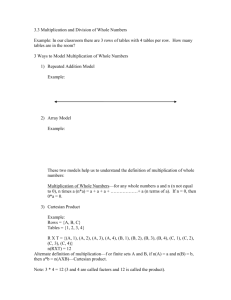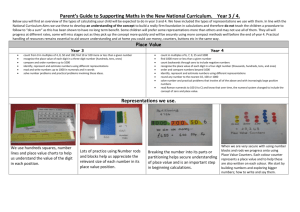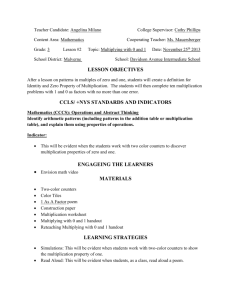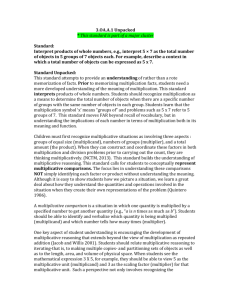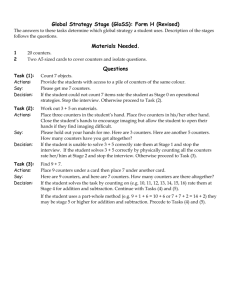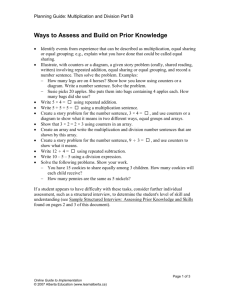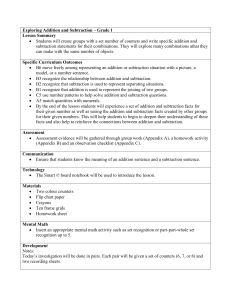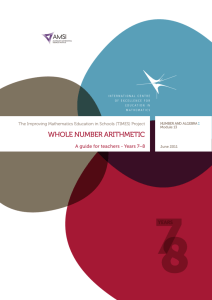Math K-3 Chapter 3
advertisement
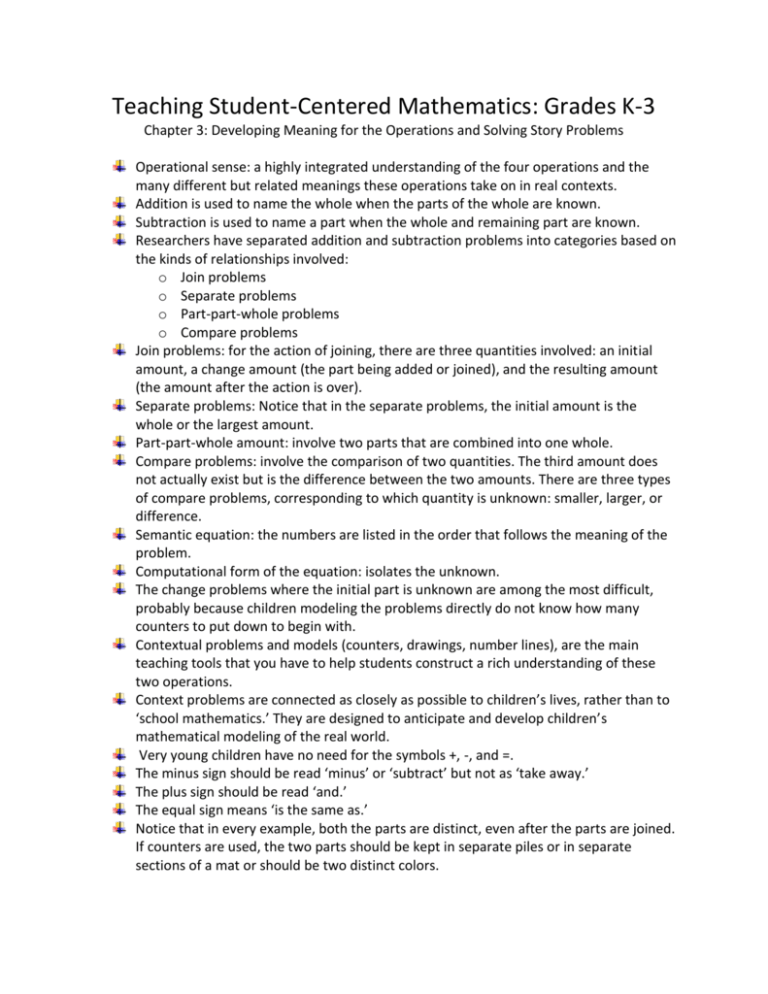
Teaching Student-Centered Mathematics: Grades K-3 Chapter 3: Developing Meaning for the Operations and Solving Story Problems Operational sense: a highly integrated understanding of the four operations and the many different but related meanings these operations take on in real contexts. Addition is used to name the whole when the parts of the whole are known. Subtraction is used to name a part when the whole and remaining part are known. Researchers have separated addition and subtraction problems into categories based on the kinds of relationships involved: o Join problems o Separate problems o Part-part-whole problems o Compare problems Join problems: for the action of joining, there are three quantities involved: an initial amount, a change amount (the part being added or joined), and the resulting amount (the amount after the action is over). Separate problems: Notice that in the separate problems, the initial amount is the whole or the largest amount. Part-part-whole amount: involve two parts that are combined into one whole. Compare problems: involve the comparison of two quantities. The third amount does not actually exist but is the difference between the two amounts. There are three types of compare problems, corresponding to which quantity is unknown: smaller, larger, or difference. Semantic equation: the numbers are listed in the order that follows the meaning of the problem. Computational form of the equation: isolates the unknown. The change problems where the initial part is unknown are among the most difficult, probably because children modeling the problems directly do not know how many counters to put down to begin with. Contextual problems and models (counters, drawings, number lines), are the main teaching tools that you have to help students construct a rich understanding of these two operations. Context problems are connected as closely as possible to children’s lives, rather than to ‘school mathematics.’ They are designed to anticipate and develop children’s mathematical modeling of the real world. Very young children have no need for the symbols +, -, and =. The minus sign should be read ‘minus’ or ‘subtract’ but not as ‘take away.’ The plus sign should be read ‘and.’ The equal sign means ‘is the same as.’ Notice that in every example, both the parts are distinct, even after the parts are joined. If counters are used, the two parts should be kept in separate piles or in separate sections of a mat or should be two distinct colors. A number line presents some real conceptual difficulties for the first and second graders. Its use as a model at that level is generally not recommended. Subtraction as “think-addition” is extremely significant for mastering subtraction facts. Because the counters for the remaining unknown part are left hidden under the cover, when children do these activities, they are encouraged to think about the hidden part: “What goes with the part I see to make the whole?” The order property (or commutative property) for addition says that it makes no difference in which order the numbers are added. Classes of multiplicative structures that are most prevalent in elementary school are: equal groups (repeated addition, rates) and multiplicative comparison. Multiplication and Division word problems: When the number and size of groups are known, the problem is a multiplication situation. When either the number of sets or the size of sets is known, division results. Problems where the size of the sets is known are called fair-sharing or partition problems. The whole is shared or distributed among a known number of sets to determine the size of each. If the number of sets is unknown but the size of the equal sets is known, the problems are called measurement or sometimes repeated-subtraction problems. It is important to combine multiplication and division soon after multiplication has been introduced in order to help students see how they are related. Experiences with making and counting groups, especially in contextual situations, are extremely useful. Important for all four operations: It remains important to use contextual problems whenever reasonable instead of mare sterile story problems. Just as with additive structures, it is a good idea to build lessons around only two or three problems. Students should solve problems using whatever technique they wish. What is important is that they explain—preferably in writing—what they did and why it makes sense. Words, pictures, and numbers remain important. Conceptually, products or quotients are not affected by the size of numbers as long as the numbers are within the grasp of the students. Little is gained by restricting early explorations of multiplication to small numbers. A remainder can be dealt with in only two ways: it can either remain a quantity left over or be partitioned into fractions. In real contexts, remainders sometimes have three additional effects in answers: o The remainder is discarded, leaving a smaller whole-number answer. o The remainder can “force” the answer to the next highest whole number. o The answer is rounded to the nearest whole number for an approximate result. To make clear the connection to addition, early multiplication activities should also include writing an addition sentence for the same model. The Order Property in Multiplication: o The order of the numbers makes no difference (the order or commutative property) o Children should draw or build arrays and use them to demonstrate why each array represents two different multiplications with the same product. Have students make up story problems that go with the results in multiplication. This approach is far preferable to an arbitrary rule, since it asks students no reason. At the K-3 level, there are many interrelated objectives that you should have in mind when you pose story problems: o Understanding the various meanings of the four operations. o Development of number skills and concepts. o Computational fluency: related to their number skills are the many different methods that students will develop for computing. There are three arguments against the key word approach: o Key words are misleading. o Many problems have no key words. o The key word strategy sends a terribly wrong message about doing mathematics. Many children in kindergarten and first grade will do better at solving problems than will students in the upper grades. Here are questions that you might have the class discuss or answer on paper. Similar questions can be used for almost any problem: o What is happening in this problem? o What will the answer tell us? o Do you think it will be a big number or a small number?

